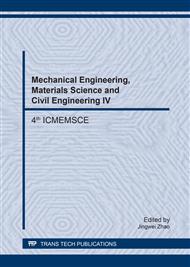[1]
J. G. Chapman, N. Jacobs, M.J. Midwinter, Pre-hospital haemostatic dressings: A systematic review, Injury, Int. J. Care Injured 42 (2011), 447-459.
DOI: 10.1016/j.injury.2010.09.037
Google Scholar
[2]
J.F. Kelly, A.E. Ritenour, D.F. McLaughlin, Injury severity and causes of death from Operation Iraqi Freedom and Operation Enduring Freedom: 2003–2004 versus 2006, J. Trauma 64 (2008), 21–27.
DOI: 10.1097/ta.0b013e318160b9fb
Google Scholar
[3]
M.A. Brown, M.R. Daya, J.A. Worley, Esperience with chitosan dressings in a cilvilian EMS system, J Emerg. Med. 37 (2009), 1–7.
Google Scholar
[4]
B. Gegel, J. Burgert, B. Cooley, J. MacGregor, J. Myers, S. Calder, R. Luellen, M. Loughren, D. Johnson, The effects of BleedArrest, Celox, and TraumaDex on hemorrhage control in a porcine model, J. Surg. Res. 164 (2010), e125–e129.
DOI: 10.1016/j.jss.2010.07.060
Google Scholar
[5]
W.A. Sakchai, P. Chureerat, Development and in vitro evaluation of chitosan–polysaccharides composite wound dressings, Int. J. Pharm. 313 (2006), 123-128.
Google Scholar
[6]
X.F. Huang, Y.F. Sun, J.Y. Nie, W.T. Lu, L. Yang, Z.L. Zhang, H.P. Yin, Z.K. Wang, Q.L. Hu, Using absorbable chitosan hemostatic sponges as a promising surgical dressing, Int. J Biol. Macromol. 75 (2015), 322–329.
DOI: 10.1016/j.ijbiomac.2015.01.049
Google Scholar
[7]
B.K. Gu, S.J. Park, M.S. Kim, C.M. Kang, J. Kim, C.H. Kim, Fabrication of sonicated chitosan nanofiber mat with enlarged porosity for use as hemostatic materials, Carbohydr. Polym. 97 (2013), 65-71.
DOI: 10.1016/j.carbpol.2013.04.060
Google Scholar
[8]
M.B. Dowling, R Kumar, M.A. Keibler, J.R. Hess, G.V. Bochicchio, S.R. Raghavan, A self-assembling hydrophobically modified chitosan capable of reversible hemostatic action, Biomaterials 32 (2011), 3351-3357.
DOI: 10.1016/j.biomaterials.2010.12.033
Google Scholar
[9]
R. Muzzarelli, Removal of uranium from solutions and brines by a derivative of chitosan and ascorbic acid, Carbohydr. Polym. 5(1985), 85-89.
DOI: 10.1016/0144-8617(85)90026-8
Google Scholar
[10]
M. Rinaudo, New Amphiphilic Grafted copolymers based on polysaccharides, Carbohydr. Polym. 83 (2011), 1338-1344.
DOI: 10.1016/j.carbpol.2010.09.054
Google Scholar
[11]
Z.M. dos Santos, A.L.P.F. Caroni, M.R. Pereira, D. R. da Silva, J.L.C. Fonseca, Determination of Deacetylation Degree of Chitosan: A Comparison between Conductometric Titration and CHN Elemental Analysis, Carbohydr. Res. 344 (2009), 2591- 2595.
DOI: 10.1016/j.carres.2009.08.030
Google Scholar
[12]
O. Ornella, D. Gerardino, M. Gaetano, C. Donato, The aggregative behavior of hydrophobically modified chitosans with high substitution degree in aqueous solution, Carbohydr. Polym. 74 (2008), 16–22.
DOI: 10.1016/j.carbpol.2008.01.009
Google Scholar
[13]
J. Desbrières, C. Martinez, M. Rinaudo, Hydrophobic derivatives of chitosan: characterization and rheological behavior, Int. J. Biol. Macromol. 19 (1996), 21-28.
DOI: 10.1016/0141-8130(96)01095-1
Google Scholar
[14]
G.P. Ma, D.Z. Yang, Y.S. Zhou, M. Xiao, J.F. Kennedy, J. Nie, Preparation and characterization of water-soluble N-alkylated chitosan, Carbohydr. Polym. 74 (2008), 121-126.
DOI: 10.1016/j.carbpol.2008.01.028
Google Scholar
[15]
Y.Y. Li, S.S. Zhang, X.J. Meng, X.G. Chen, G.D. Ren, The Preparation and characterization of a novel amphiphilic oleoyl-carboxymethyl chitosan self-assembled nanoparticles, Carbohydr Polym. (83) 2011, 130-136.
DOI: 10.1016/j.carbpol.2010.07.030
Google Scholar
[16]
K. Almdal, J. Dyre, S. Hvidt, O. Kramer, Towards a phenomenological definition of the term gel, Polym. Gels Networks 1 (1993), 5-17.
DOI: 10.1016/0966-7822(93)90020-i
Google Scholar
[17]
Q. He, J. Guan, M.L. Jing, S.J. Huang, C. Xu, Z.H. Li, J.M. Wu, X.Z. Zhang, Synthesis and characterization of hydrophobically modified chitosan, Afr. J Pharm. Pharmaco. 6 (2012), 3285-3292.
DOI: 10.5897/ajpp12.1427
Google Scholar


